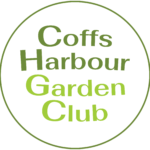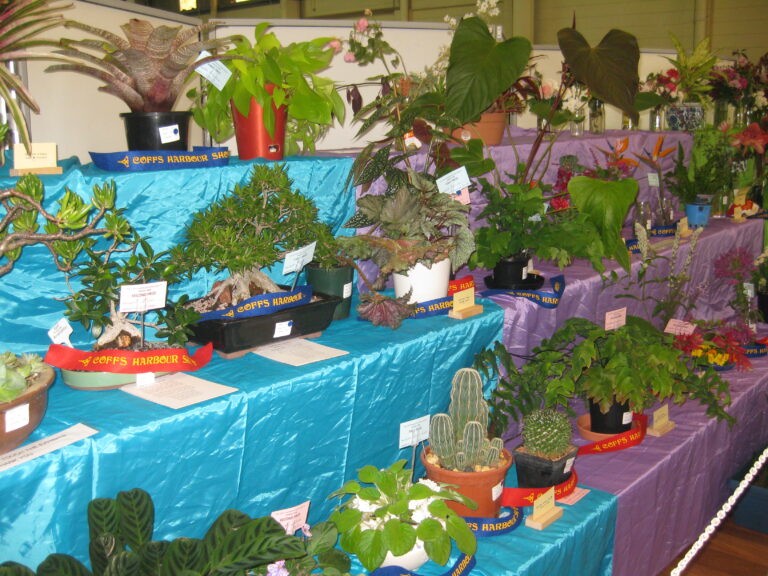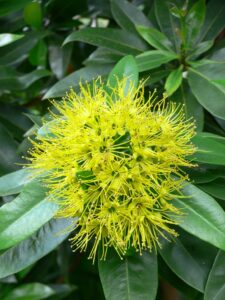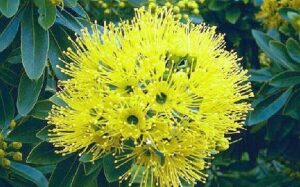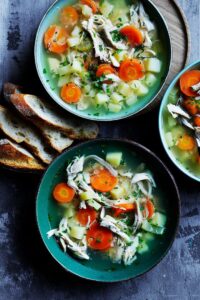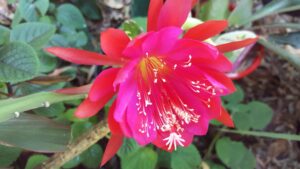The Coffs Harbour Show is coming up 30th April – 2 May and CHGC Member Ruth is going to present some hints and tips for exhibiting at this Regional Show. For further information about show sections and classes please visit here.
Ruth will give guidelines on placing exhibits on our monthly competition table too. If you want to see more about our competition table categories etc please visit here.
Some general guidelines to exhibiting at a show – these guidelines are drawn from the Royal Horticultural Society of NSW Judging Standards and Guidelines for Horticultural Competitions and Exhibitions.
THE MOST IMPORTANT STEP TO EXHIBITING IS READ THE SCHEDULE
Section 10 – Eggs, Nuts, Honey, Fruit & Vegetables
Judges are looking for what is typical of the variety, free from disease, insect or other damage, clean, fresh and be of uniform size, shape and colour.
Eggs: undamaged, matched for uniformity of colour & size, displayed in a clean undamaged carton. Clean by damp cloth if absolutely necessary.
Nuts: named variety if possible.
Honey: clean jars, honey surface free of dust and wax particles and no scum or froth evident and of clear quality, exhibited in a clear jar.
Asian Vegetable any variety: Rinse if needed.
Avocado: uniform cultivar with 2cm stem attached.
Beans: should be straight, same in length, width and freshness with a length of stem or haulm at the top 1 – 1.5cm. Do not wash
Carrots: tops on: straight, smooth skin free of cracks, greening or side roots, tops trimmed down to 7 – 10cm. Rinse clean do not scrub.
Chillies, collection: shape and colour should be typical of the variety, trim stems to 1 – 1.5cm. Wipe with soft, dry cloth.
Chockos: without any shoots visible. Clean by wiping with dry cloth.
Citrus: The stems should be cut close to the surface of the rind leaving green plump sepals. Clean by damp cloth do not wax.
Cucumbers: Straight, firm, blunt ends with stem trimmed 1 – 1.5cm. Clean by wiping with a soft, dry cloth or moist cloth if necessary.
Garlic: firm to the touch, papers tight, with the head well cured.
Guava: Clean with a damp cloth.
Lettuce any variety: well developed plants with firm, crisp leaves & any outer loose, discoloured leaves removed with roots (can be exhibited in water).
Paw paw: blemish free, even colour. Clean with a damp cloth.
Passionfruit: unblemished and unwrinkled with stem attached.
Peas: well developed pods, 1 – 1.5cm stem attached. Do not wash
Potatoes: fully mature, free of insect/disease, injury, cracks, sunburn or greening. After tubers have dried, clean by brushing lightly to remove soil or wash very carefully. Do not mix varieties.
Pumpkins, squash, marrow, gramma and melon: good colour, thick fleshed and heavy in weight for size of specimen, trim stem to 5cm. Clean by wiping and polishing with a dry cloth or wash carefully.
Rhubarb: stalks at least 25cm long and 2.5cm thick with smooth skin and well coloured, trim base squarely. Do not mix cultivars. Leaves may be trimmed to 5cm. Clean by wiping with dry cloth or washing if necessary.
Rosellas: bright, unblemished, with the calyx and seedpod intact.
Silver Beet Bunch: large, broad, thick and cut squarely. Rinse if necessary.
Spring Onions: straight plants 1 – 1.5cm thick stems, older outer leaves removed, roots trimmed. Rinse clean.
Tomatoes: firm, deep characteristic colour displayed with or without stems. Green tomatoes should be entirely green. Clean by wiping with moist cloth.
Zucchini: straight, with 1 – 1.5cm stem attached. Clean with moist cloth.
Collection of 5 named herbs: when picking herbs for exhibition they are best picked the day before and hardened off by placing in warm water. Before exhibiting, recut stems without crushing. The herbs can be placed in water to keep them fresh. This collection may be displayed in a decorative manner.
Collection of Vegetables grown by exhibitor: these can be displayed in an attractive basket or box.
THE MOST IMPORTANT STEP TO EXHIBITING IS READ THE SCHEDULE
Section 14 – Flowers & Plants
Judges are looking for what is typical of the flower or plant, free from disease, insect or other damage, clean and fresh.
There are bottles provided (soft drink bottles), however you may use a container of your own choice. This container must be of clear glass for the cut flower classes.
Plan to cut your flowers in the evening or early morning. Always cut the stem several cms longer than necessary to allow for later trimming. Use a clean, sharp knife to make a smooth, even cut. Remove any leaves on the stem that will be in water.
‘Conditioning’ or ‘hardening’ reduces the chances of stem blockage and promotes the quick water uptake necessary for long flower life. When cutting your blooms take a bucket of warm water with you and immediately place the stems in the water after cutting. Place the bucket in a cool spot and never near any fruits or vegetables.
For the best display, flowers should be in proportion to the height of the container.
Pack the stem in the bottle neck using kitchen towel or oasis so that the stem is held firm for judging and display purposes.
Specimen flowers must have own stem and foliage.
Always count your stems to make sure that you have the correct number.
Flowers should be at their peak and cut as long as possible (avoiding stem-on-stem) and have straight stems with clean foliage..
A bud for display purposes is a bud from the time the calyx opens and colour is visible, once the petals commence to unfurl it becomes a bloom.
A bowl is a vessel that has a diameter equal or greater than the height. The diameter of the mouth is to be not less than two thirds of the total diameter. Anything less is defined as a vase.
A vase is where the height should be greater than the width.
Oasis or floral foam may be used but must be concealed in floral art.
Label exhibits; this is important as the purpose of a Show is education as well as competition. Other exhibitors and the public may be interested in growing varieties that have been exhibited. For pots both the scientific name and common name is desired.
Float bowls: flowers should be displayed with ‘room’ around them so that it can be observed that the blooms are indeed floating.
Pots:
Use clean containers that are in proportion to plant size. The colour, texture and style should complement the plant without drawing attention away from it. Baby oil can be used to remove mineral deposits from pots.
Foliage plants are judged on the quality and appearance of leaves and stems.
Flowering plants are judged for their display of flowers but should not show obvious foliage damage.
Plant size: good branching is often more desirable than extra height.
Plant shape: should be symmetrical, pots turned regularly will have good symmetry.
Potted plants have to be firm in their pots – not recently repotted.
Groom carefully: remove any damaged leaves and spent flowers however don’t leave any obvious wounds.
Care has to be taken when transporting pots, wrap newspaper around the foliage to protect it and pack the pot firmly so it doesn’t fall over.
DO NOT PUT OIL ON LEAVES of plants. Leaves should be cleaned of all dirt but not coated in anything.
